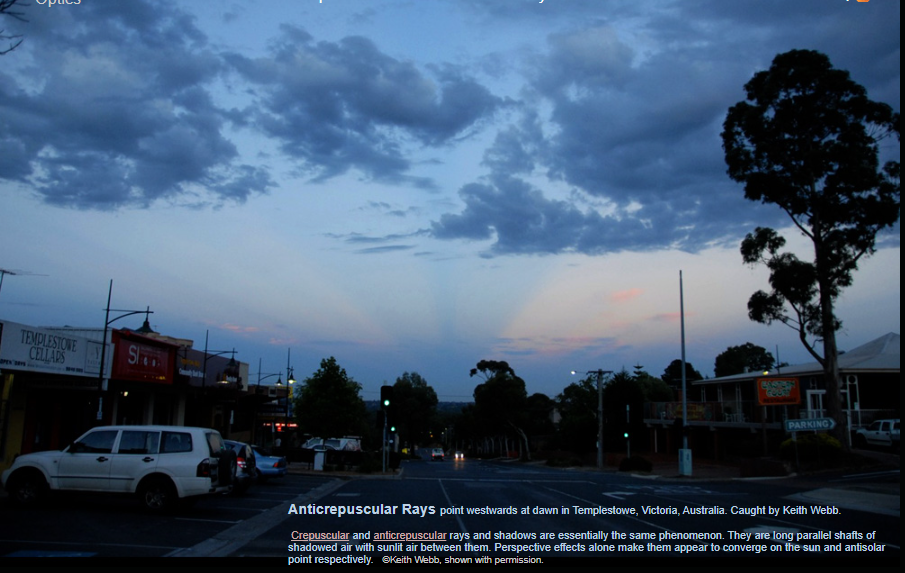Dawn Anticrepusculars
Dawn Anticrepusculars: A Fascinating Atmospheric Phenomenon
Have you ever witnessed a captivating display of light and shadow during the early hours of dawn? If so, you may have been fortunate enough to observe a phenomenon known as "dawn anticrepusculars." Similar to their crepuscular counterparts, these optical marvels are a breathtaking display of parallel rays and shadows, adding an enchanting touch to the morning sky. In this article, we will delve into the world of dawn anticrepusculars, exploring their formation, characteristics, and the science behind their captivating beauty.
What are Dawn Anticrepusculars?
Dawn anticrepusculars are atmospheric optical phenomena that occur during the early morning hours, just before sunrise. They are essentially the same as crepuscular rays and shadows, characterized by long, parallel shafts of shadowed air with sunlit air between them. However, what sets dawn anticrepusculars apart is their unique orientation. While crepuscular rays appear to radiate from the sun, dawn anticrepusculars seemingly converge on the antisolar point, which is the point directly opposite the sun.
The Science Behind Dawn Anticrepusculars
The formation of dawn anticrepusculars can be attributed to perspective effects and the scattering of sunlight by atmospheric particles. When the sun is low on the horizon during the early morning hours, its rays pass through a larger portion of the Earth's atmosphere. As sunlight interacts with tiny particles such as dust, water droplets, and ice crystals suspended in the air, it scatters in various directions. This scattering phenomenon gives rise to the mesmerizing display of dawn anticrepusculars.
Factors Influencing Dawn Anticrepusculars
Several factors contribute to the formation and appearance of dawn anticrepusculars:
-
Atmospheric Conditions: The presence of atmospheric particles, such as dust or water droplets, plays a crucial role in the scattering of sunlight and the creation of dawn anticrepusculars. Different particle sizes and concentrations can lead to variations in the intensity and color of these phenomena.
-
Geographical Location: The orientation and visibility of dawn anticrepusculars may vary depending on the observer's location on Earth. Due to the curvature of the planet, the antisolar point will differ at various latitudes, resulting in different angles at which the rays converge.
-
Weather Patterns: Weather conditions, such as cloud cover or haze, can either enhance or obscure the visibility of dawn anticrepusculars. Clear skies provide an ideal canvas for these phenomena to be prominently displayed.
Capturing the Beauty of Dawn Anticrepusculars
If you're eager to witness and capture the allure of dawn anticrepusculars, here are some tips to maximize your chances:
-
Early Morning Vigil: Set your alarm clock and wake up before sunrise to catch these elusive phenomena. The optimal time to observe dawn anticrepusculars is when the sun is just below the horizon, casting its rays across the sky.
-
Unobstructed Views: Find a location with a clear view of the horizon, free from tall buildings or obstructing structures. This will provide an unobstructed canvas for the convergence of dawn anticrepuscular rays.
-
Patience and Persistence: Atmospheric phenomena can be unpredictable, so it's essential to be patient and persistent in your quest to witness dawn anticrepusculars. Keep your eyes peeled and be prepared to capture the moment when it presents itself.
The Magic of Dawn Anticrepusculars
Dawn anticrepusculars offer a mesmerizing glimpse into the wonders of our atmosphere. As sunlight interacts with atmospheric particles, it creates a symphony of light and shadow, painting the morning sky with ethereal beauty. These phenomena serve as a reminder of the intricate workings of our planet's atmosphere and the awe-inspiring phenomena it can produce.
So, the next time you find yourself awake before sunrise, take a moment to gaze at the sky. You might just be lucky enough to witness the enchanting dance of dawn anticrepusculars, an experience that will leave you in awe of the natural wonders that surround us.

Anticrepuscular Rays point westwards at dawn in Templestowe, Victoria, Australia. Caught by Keith Webb.
Crepuscular and anticrepuscular rays and shadows are essentially the same phenomenon. They are long parallel shafts of shadowed air with sunlit air between them. Perspective effects alone make them appear to converge on the sun and antisolar point respectively. ©Keith Webb, shown with permission.
Note: this article has been automatically converted from the old site and may not appear as intended. You can find the original article here.
Reference Atmospheric Optics
If you use any of the definitions, information, or data presented on Atmospheric Optics, please copy the link or reference below to properly credit us as the reference source. Thank you!
-
<a href="https://atoptics.co.uk/blog/dawn-anticrepusculars/">Dawn Anticrepusculars</a>
-
"Dawn Anticrepusculars". Atmospheric Optics. Accessed on November 26, 2024. https://atoptics.co.uk/blog/dawn-anticrepusculars/.
-
"Dawn Anticrepusculars". Atmospheric Optics, https://atoptics.co.uk/blog/dawn-anticrepusculars/. Accessed 26 November, 2024
-
Dawn Anticrepusculars. Atmospheric Optics. Retrieved from https://atoptics.co.uk/blog/dawn-anticrepusculars/.